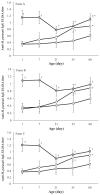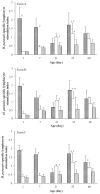Program of vaccination and antibiotic treatment to control polyserositis caused by Haemophilus parasuis under field conditions
- PMID: 24101794
- PMCID: PMC3700443
Program of vaccination and antibiotic treatment to control polyserositis caused by Haemophilus parasuis under field conditions
Abstract
The present study investigated the effects of vaccinating sows and piglets or piglets alone against Haemophilus parasuis on the prevalence of H. parasuis in nasal swabs, on the humoral and cellular immune responses, and on the production parameters of piglets at 3 Korean farms with a clinical history of polyserositis caused by H. parasuis. Piglets born to vaccinated or non-vaccinated sows were subdivided into 3 groups: vaccinated sows and vaccinated pigs (VS-VP), non-vaccinated sows and vaccinated pigs (NVS-VP), and non-vaccinated sows and non-vaccinated pigs (NVS-NVP). The proportion of piglets with positive nasal swabs was significantly lower (P < 0.05) in the vaccinated animals (VS-VP and NVS-VP groups) than in the non-vaccinated animals (NVS-NVP group) at 35 and 60 d of age at the 3 farms. The overall growth performance (from 7 to 60 d of age) of the vaccinated piglets was significantly better (P < 0.05) than that of the non-vaccinated piglets at the 3 farms. Piglets in the VS-VP group had significantly higher levels (P < 0.05) of H. parasuis-specific IgG antibodies, lymphocyte proliferation, and interferon-γ-secreting cells than piglets in the NVS-VP and NVS-NVP groups on days 1, 7, 21, 35, and 60 after birth at the 3 farms.
Ce projet visait à étudier les effets de la vaccination contre Haemophilus parasuis des truies et des porcelets ou des porcelets uniquement sur la prévalence d’H. parasuis dans des écouvillons nasaux, sur les réponses immunitaires humorale et cellulaire, et sur les paramètres de production des porcelets dans trois fermes coréennes avec une histoire de cas cliniques de polysérosites causés par H. parasuis. Les porcelets nés de truies vaccinées et non-vaccinées ont été répartis en trois groupes : truies vaccinées et porcelets vaccinés (VS-VP), truies non-vaccinées et porcelets vaccinés (NVS-VP), et truies non-vaccinées et porcelets non-vaccinés (NVS-NVP). La proportion de porcelets positifs pour H. parasuis à partir de l’écouvillon nasal était significativement plus faible (P < 0,05) chez les animaux vaccinés (groupes VS-VP et NVS-VP) que chez les animaux non-vaccinés (groupe NVS-NVP) à 35 et 60 jours d’âge sur les trois fermes. Sur les 3 fermes, les performances de croissance globales (de 7 à 60 jours d’âge) des porcelets vaccinés étaient significativement meilleures (P < 0,05) que celles des porcelets non-vaccinés. Sur les trois fermes, les porcelets du groupe VS-VP avaient des niveaux significativement plus élevés (P < 0,05) d’anticorps IgG spécifiques contre H. parasuis, de prolifération lymphocytaire, et de cellules secrétant de l’interféron-γ que les porcelets dans les groupes NVS-VP et NVS-NVP aux jours 1, 7, 21, 35, et 60 après la naissance.(Traduit par Docteur Serge Messier).
Figures

 ), the group of non-vaccinated sows and vaccinated piglets (NVS-VP group; ○), and the group of non-vaccinated sows and non-vaccinated piglets (NVS-NVP group;
), the group of non-vaccinated sows and vaccinated piglets (NVS-VP group; ○), and the group of non-vaccinated sows and non-vaccinated piglets (NVS-NVP group;
 ) at 3 farms in Korea. Variation is standard deviation. Significant differences are indicated by the symbols (P < 0.001†) and (P < 0.05*).
) at 3 farms in Korea. Variation is standard deviation. Significant differences are indicated by the symbols (P < 0.001†) and (P < 0.05*).

 ), the group of non-vaccinated sows and vaccinated piglets (NVS-VP group; ○), and the group of non-vaccinated sows and non-vaccinated piglets (NVS-NVP group;
), the group of non-vaccinated sows and vaccinated piglets (NVS-VP group; ○), and the group of non-vaccinated sows and non-vaccinated piglets (NVS-NVP group;
 ); and mean number of H. parasuis-specific interferon-γ-secreting cells (IFN-γ-SCs) per million PBMCs/mL in the the group of vaccinated sows and vaccinated piglets (VS-VP group; ▦), the group of non-vaccinated sows and vaccinated piglets (NVS-VP group; □), and the group of non-vaccinated sows and non-vaccinated piglets (NVS-NVP groups; ▥). Variation is standard deviation. Significant differences are indicated by the symbols (P < 0.001†) and (P < 0.05*).
); and mean number of H. parasuis-specific interferon-γ-secreting cells (IFN-γ-SCs) per million PBMCs/mL in the the group of vaccinated sows and vaccinated piglets (VS-VP group; ▦), the group of non-vaccinated sows and vaccinated piglets (NVS-VP group; □), and the group of non-vaccinated sows and non-vaccinated piglets (NVS-NVP groups; ▥). Variation is standard deviation. Significant differences are indicated by the symbols (P < 0.001†) and (P < 0.05*).Similar articles
-
Serologic profiling of Haemophilus parasuis-vaccinated sows and their litters using a novel oligopeptide permease A enzyme-linked immunosorbent assay reveals unexpected patterns of serological response and maternal antibody transfer.J Vet Diagn Invest. 2014 Jan;26(1):125-30. doi: 10.1177/1040638713510163. Epub 2014 Jan 9. J Vet Diagn Invest. 2014. PMID: 24407228
-
Sow vaccination modulates the colonization of piglets by Haemophilus parasuis.Vet Microbiol. 2010 Oct 26;145(3-4):315-20. doi: 10.1016/j.vetmic.2010.04.002. Epub 2010 Apr 14. Vet Microbiol. 2010. PMID: 20447775
-
Comparison between Haemophilus parasuis infection in colostrums-deprived and sow-reared piglets.Vet Microbiol. 2004 Oct 5;103(1-2):21-7. doi: 10.1016/j.vetmic.2004.06.011. Vet Microbiol. 2004. PMID: 15381262
-
Haemophilus parasuis: new trends on diagnosis, epidemiology and control.Vet Microbiol. 2004 Mar 26;99(1):1-12. doi: 10.1016/j.vetmic.2003.12.001. Vet Microbiol. 2004. PMID: 15019107 Review.
-
Prevalence of Haemophilus parasuis"Glaesserella parasuis" in pigs in China: A systematic review and meta-analysis.Prev Vet Med. 2020 Sep;182:105083. doi: 10.1016/j.prevetmed.2020.105083. Epub 2020 Jul 1. Prev Vet Med. 2020. PMID: 32652336
Cited by
-
Vaccination Failures in Pigs-The Impact of Chosen Factors on the Immunisation Efficacy.Vaccines (Basel). 2023 Jan 19;11(2):230. doi: 10.3390/vaccines11020230. Vaccines (Basel). 2023. PMID: 36851108 Free PMC article. Review.
References
-
- Brown CC, Baker DC, Barker IK. Alimentary system. In: Maxie MG, editor. Jubb, Kennedy, and Palmer’s Pathology of Domestic Animals. 5th ed. Philadelphia, Pennsylvania: Saunders; 2007. pp. 288–289.
-
- Kang I, Kim D, Han K, et al. Optimized protocol for multiplex nested polymerase chain reaction to detect and differentiate Haemophilus parasuis, Streptococcus suis, and Mycoplasma hyorhinis in formalin-fixed, paraffin-embedded tissues from pigs with polyserositis. Can J Vet Res. 2012;76:195–200. - PMC - PubMed
-
- Rapp-Gabrielson VJ, Oliveira SR, Pijoan C. Haemophilus parasuis. In: Straw BE, Zimmerman LL, D’Allaire S, Taylor DJ, editors. Diseases of Swine. 9th ed. Chichester, England: Blackwell Publishing; 2006. pp. 681–690.
-
- Nedbalcova K, Satran P, Jaglic Z, Ondriasova R, Kucerova Z. Haemophilus parasuis and Glässer’s disease in pigs: A review. Vet Med. 2006;51:168–179.
-
- Bak H, Riising H-J. Protection of vaccinated pigs against experimental infections with homologous and heterologous Haemophilus parasuis. Vet Rec. 2002;151:502–505. - PubMed
Publication types
MeSH terms
Substances
LinkOut - more resources
Full Text Sources
Medical
